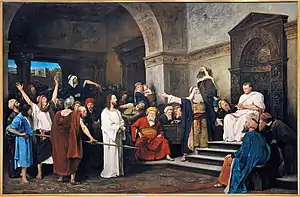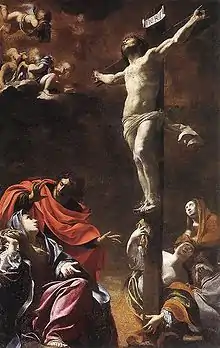Luke 23
Luke 23 is the twenty-third chapter of the Gospel of Luke in the New Testament of the Christian Bible. The book containing this chapter is anonymous, but early Christian tradition uniformly affirmed that Luke composed this Gospel as well as the Acts of the Apostles.[1] This chapter records the trial of Jesus Christ before Pontius Pilate, Jesus' meeting with Herod Antipas, and his crucifixion, death and burial.[2]
| Luke 23 | |
|---|---|
.jpg.webp) The Greek text of Luke 23:47-24:1 on Codex Bezae (Cambridge University Library MS. Nn.2.41), written about AD 400. | |
| Book | Gospel of Luke |
| Category | Gospel |
| Christian Bible part | New Testament |
| Order in the Christian part | 3 |
Text
The original text was written in Koine Greek. This chapter is divided into 56 verses.
Textual witnesses
Some early manuscripts containing the text of this chapter are:
- Papyrus 75 (AD 175-225)
- Codex Vaticanus (325-350)
- Codex Sinaiticus (330-360)
- Codex Bezae (c. 400)
- Codex Washingtonianus (c. 400)
- Codex Alexandrinus (400-440)
- Codex Ephraemi Rescriptus (c. 450; extant verses 26-56)
Old Testament references
Verse 1
- And the whole multitude of them arose, and led him unto Pilate.[5]
- "The whole multitude of them" (also in NKJV): or 'the whole Council' (Greek: απαν το πληθος, hapan to plēthos) led Jesus to Pontius Pilate, the provincial governor (prefect) of Judaea.
Verse 3

Cross reference: Matthew 27:11; Mark 15:2; John 18:37
Verse 3 in Greek
Textus Receptus/Majority Text:
- ὁ δὲ Πιλάτος ἐπηρώτησεν αὐτόν, λέγων, Σὺ εἶ ὁ βασιλεὺς τῶν Ἰουδαίων;
- ὁ δὲ ἀποκριθεὶς αὐτῷ ἔφη, Σὺ λέγεις.
Transliteration:
- Ho de Pilatos epērōtēsen auton, legōn, "Su ei ho basileus tōn Ioudaiōn?":
- Ho de apokritheis autō ephē, "Su legeis."
Verse 3 in Latin
- Pilatus autem interrogavit eum dicens tu es rex Iudaeorum
- at ille respondens ait tu dicis.
The style of response is the same as in Luke 22:70, where Jesus answers the Sanhedrin's question, "Are you the Son of God?"
Verse 24
- So Pilate gave sentence that it should be as they requested.[7]
This verse reads ο δε πιλατος επεκρινεν γενεσθαι το αιτημα αυτων in the Textus Receptus, matching the opening words of Mark 15:15, ο δε πιλατος ("so Pilate ..."), but the sentence begins καὶ Πιλᾶτος ... ("and Pilate ...") in critical texts such as Westcott-Hort.[8] Pilate's "official decision" [9] was to comply with the request of the crowd. The word ἐπέκρινεν (epekrinen, "pronounced sentence") is specific to Luke,[10] although it also appears in the apocryphal 2 Maccabees 4:47, where innocent men are condemned to death.[11][12]
Verse 29
.jpg.webp)
- Blessed are the barren, and the wombs that never bore and the breasts which never gave suck.[13]
The prophet Hosea spoke in similar language, when recognising that the disobedience of Israel required God's punishment, but calling for some mitigation:
- Give them, O Lord —
- what will you give?
- Give them a miscarrying womb
- and dry breasts.[14]

Verse 44
- Now it was about the sixth hour, and there was darkness over all the earth until the ninth hour.[16]
Like Mark 15:33–34, Luke records three hours of darkness, which signify "the awesomeness of what is taking place".[17]
Verse 46
- And when Jesus had cried out with a loud voice, He said, “Father, ‘into Your hands I commit My spirit.’ ” Having said this, He breathed His last.[18]
Jesus' crying "with a loud voice" is not, as in Mark 15:34, one of desolation (why have you forsaken me?), but of "secure confidence". Jesus quotes Psalm 31:5, rather than Psalm 22:1 which appears in Mark's gospel.[17]
Verse 49
- And all his acquaintance, and the women that followed him from Galilee, stood afar off, beholding these things.[19]
"The women" that followed Jesus from Galilee (also in Luke 53:55) were "Mary Magdalene, Joanna, Mary the mother of James, and the other women with them" according to Luke 24:10.[20] Matthew 27:55 lists "Mary Magdalene, Mary the mother of James and Joseph, and the mother of the sons of Zebedee", whereas Mark 15:40 names "Mary Magdalene, Mary the mother of James the little and Joses, and Salome".[21]
Verse 55
- And the women who had come with Him from Galilee followed after, and they observed the tomb and how His body was laid.[22]
According to Luke 24:10, "the women" (also in Luke 53:49) were "Mary Magdalene, Joanna, Mary the mother of James, and the other women with them".[20] Matthew 27:61 lists "Mary Magdalene, and the other Mary", whereas Mark 15:47 names "Mary Magdalene, and Mary the mother of Joses".[21]
See also
References
- Holman Illustrated Bible Handbook. Holman Bible Publishers, Nashville, Tennessee. 2012.
- Halley, Henry H. Halley's Bible Handbook: an Abbreviated Bible Commentary. 23rd edition. Zondervan Publishing House. 1962.
- Kirkpatrick 1901, p. 838.
- Kirkpatrick 1901, p. 839.
- Luke 23:1 KJV
- Luke 23:3 NRSV
- Luke 23:24: NKJV
- Meyer, H. A. W., Meyer's NT Commentary on Luke 23, accessed 23 August 2020
- Luke 23:24: J. B. Phillips' translation
- Englishman's Concordance: ἐπέκρινεν, accessed 23 August 2020
- 2 Maccabees 4:47: New American Bible, Revised Edition
- Farrar, F. W., Cambridge Bible for Schools and Colleges on Luke 23, accessed 23 August 2020
- Luke 23:29 KJ21
- Hosea 9:14 ESV
- Luke 23:1: Geneva Bible
- Luke 23:44
- Franklin, E., Luke in Barton, J. and Muddiman, J. (2001), The Oxford Bible Commentary, p. 957
- Luke 23:46
- Luke 23:49 KJV
- Bauckham 2017, pp. 49, 131.
- Bauckham 2017, p. 49.
- Luke 23:55 NKJV
Bibliography
- Bauckham, Richard (2017). Jesus and the Eyewitnesses (2nd ed.). Wm. B. Eerdmans Publishing. ISBN 9780802874313.
- Kirkpatrick, A. F. (1901). The Book of Psalms: with Introduction and Notes. The Cambridge Bible for Schools and Colleges. Book IV and V: Psalms XC-CL. Cambridge: At the University Press. Retrieved February 28, 2019.
External links
- Luke 23 King James Bible - Wikisource
- English Translation with Parallel Latin Vulgate
- Online Bible at GospelHall.org (ESV, KJV, Darby, American Standard Version, Bible in Basic English)
- Multiple bible versions at Bible Gateway (NKJV, NIV, NRSV etc.)
| Preceded by Luke 22 |
Chapters of the Bible Gospel of Luke |
Succeeded by Luke 24 |